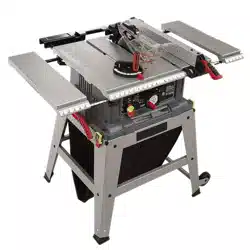Loading ...
Loading ...
Loading ...

USING THE MITER GAUGE
The MITER GAUGE is used when CROSSCUTTING,
MITER CUTTING, BEVEL CUTTING, COMPOUND
MITER CUTTING, DADOING and when RABBETTING
AND MOLDING across the end of a narrow workpiece.
WARNING: FOR YOUR OWN SAFETY, ALWAYS
OBSERVE THE FOLLOWING SAFETY PRECAU-
TIONS IN ADDITION TO THE SAFETY INSTRUC-
TIONS ON PAGES 2, 3, 4, 5, 6, 26, 27, AND 28.
ADDITIONAL SAFETY iNSTRUCTiONS
FOR CROSS CUT TYPE CUTS
Before starting
- NEVER use the rip fence when crosscutting.
- An auxiliary wood facing attached to the miter
gauge can help prevent workpiece twisting and
throwbacks. Attach it to the holes provided.
Make the facing long enough and big enough to
support your work. Make sure, however, it will
not in.terfere with the sawblade guard.
- Use jigs or fixtures to help hold any piece too
small to extend across the full length of the miter
gauge face during the cut. This lets you properly
hold the miter gauge and workpiece and helps
keep your hands away from the blade.
While cutting
- To avoid blade contact, always hold the miter
gauge as shown in the BASIC SAW OPERA-
TIONS- USING THE MITER GAUGE.
CROSSCUTTING
Crosscut
A cutting or shaping operation made across the width
of the workpiece.
The graduations on the miter gauge provide
accuracy for average woodworking. In some cases
where extreme accuracy is required, when making
angle cuts, for example, make a trial cut and then
recheck it with an accurate square, or protractor.
If necessary, the miter gauge head can be swiveled
slightly to compensate for any inaccuracy.
NOTE: The space between the miter gauge barand
the groove in the table is held to a minimum during
manufacturing
For maximum accuracy when using the miter
gauge, always "favor" one sade of the groove in the
table. In other words, don't move the miter gauge
from side to side while cutting, but keep one side of
the bar riding against one side of the groove.
NOTE: Glue a piece of sandpaoer to the face of the
miter gauge head. This will help prevent the
workpiece from "creeping" while it is being cut.
The Hold-Down Clamp (Optional Accessory)
sP]ould be used on the miter gauge for greater
accuracy.
The miter gauge may _e used in either of the
grooves m the table. Make sure it is locked.
WARNING: TO AVOID BLADE CONTACT, HOLD THE
MITER GAUGE PROPERLY.
When using the miter gauge in the LEFT hand
groove, hold the workpiece firmly against the miter
gauge head with your left hand. and grip the Fock
handle with your r_ght.
When using the RIGHT Hand groove, hold the
workpiece with your right hand and the !ockhandle
with your left hand
When cutting long workpieces, insert AUXILIARY
FENCE/WORK SUPPORT and position it on top of the
guide bars to support the workpiece as near to the end
as possible. If this does not adequately support the
workpiece, you can make a simple support by clamping
a piece of plywood to a sawhorse. See first illustration
under "Crosscutting.
\
\
PER
AUXILIARY FENCE!
WORK SUPPORT
ir
WORKPIECE
1
l I Jt l-2
TABLE
\
\
\
Use a Hold-Down Clamp (Optional Accessory) on the
miter gauge for greater accuracy,
29
Loading ...
Loading ...
Loading ...
